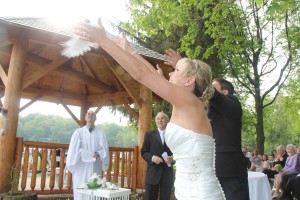Traditions

The bride should wear one of the following:
Something old: a link to the bride’s family and her old life;
Something new: invite fortune and success during this new life;
Something borrowed: lucky charm for the couple;.
Something blue: reference to biblical times – purity and fidelity.
Six pences (at a current value of $1.00)
If placed by the father of the bride in her left shoe, should bring fortune.
During the Middle Ages, to reflect non acceptable actions, a straw ring was used to marry the couples that were obligated to wed due to early consummation of the marriage. They were united in Paris, in one of the small churches, Ste-Martine.
During Orthodox ceremonies, the groom wears a gold ring symbolizing the sun and the bride wears a silver ring symbolizing the moon.
The Hindu marriage is delicate and colourful. The preparations are complex and the marriage is sacred. A Hindu God always has a wife. Siva is never represented alone; his companion Parvatti is always by his side. As a result, the traditional wedding is themost important ritual to inspire the person’s life from birth to death. The wedding may last several days and is celebrated before or after the harvesting and at an acceptable date in the Hindu calendar.
The tchang daï ritual (tie the hands with a cotton link), is a ritual used in Laos,Vietnam and Cambodia. This ritual is a symbol of happiness and represents a mystical link. The bonds must only be removed on the day following the marriage.
In the Maoris of New Zealand, the ring is an engraved bone.
The Swedish tradition is that after the exchange of vows, the newlyweds mutually tiethree ribbons on their ring finger. The first one as a sign of their commitment, the second on as a sign of their alliance and the third is a promise of maternity.
In Porto Rico, a doll dressed up as a bride like the one celebrating is placed in the middle of the table of honour. Miniature copies are offered to each guest as a souvenir of the wedding.
In the Philippines and in Armenia, two doves are released during the marriage ceremony. By releasing the birds, the couple identifies their commitment to spreading peace.
Provide your guests with a large container of rose, lavender or rosemary scented water, where they may dip there hands before the ceremony. It is for all a symbol of the purification of the heart.
You may offer your grand-parents a cup of tea (or a rose) with respect to your elders in recognition of the values they will or have left behind.
Baskets filled with scarves (while muslin) and handed out to your guests. Each guest will receive one and pass it on to his neighbour while embracing this person. The scarves are passed on to each guest. The newlyweds exchange their scarves. This Provencal tradition is a symbol of peace, commitment and love. /p>
When leaving the ceremony as husband and wife, you may cut a ribbon as a symbol of the beginning of your new life.
In Japan, to wish happiness to someone, we offer those grains of rice coloured inred. In the following ceremony the Shintoist ritual is a form of Imperial Japanese. This is a very important day where people may wear kimonos not worn on a typical day. It is the moment to create a solid bond with the past.
You may walk barefoot on the road to your new life to be closer to the earth or simply for the pleasure of a sensual and reassuring physical contact.
You may plant a tree on your wedding day. It represents the lifelong evolution and is also a symbol of fertility. Every year, when the tree is in bloom, it symbolizes therenewed love between the spouses.
